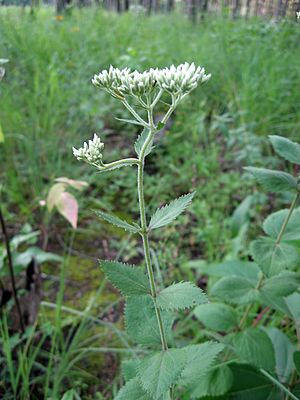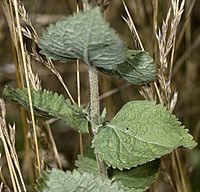Roundleaf thoroughwort facts for kids
Quick facts for kids Roundleaf thoroughwort |
|
|---|---|
 |
|
| Conservation status | |
| Scientific classification | |
| Genus: |
Eupatorium
|
| Species: |
rotundifolium
|
| Synonyms | |
|
Synonymy
Critonia elliptica Raf. ex DC.
Eupatorium marrubium Walter Eupatorium obovatum Raf. Eupatorium ovatum J.Bigelow Eupatorium rotundifolium Fernald 1943 not L. 1753 Eupatorium teucrifolium Willd. Eupatorium verbenaefolium Michaux Eupatorium verbenifolium Reichard Uncasia pubescens (Mühlenb. ex Willd.) Greene Uncasia rotundifolia (L.) Greene Uncasia scabrida (Elliott) Greene Uncasia verbenaefolia (Michaux) Greene Uncasia verbenifolia (Michaux) Greene</h> Eupatorium pubescens Muhl. ex Willd., syn of var. ovatum Eupatorium scabridum Elliott, syn of var. scabridum |
|
Eupatorium rotundifolium, also known as roundleaf thoroughwort, is a plant found in North America. It belongs to the sunflower family. This plant grows naturally in the eastern and central United States. You can find it in all the states along the coast from Maine to Texas. It also grows further inland in places like Missouri and the Ohio Valley. It likes to grow in wet areas such as damp savannas and bogs.
What it Looks Like
This plant has stems that can grow up to 100 centimeters (about 40 inches) tall. These stems grow from short underground stems called rhizomes. The plant's flowers grow in groups called inflorescences. These groups have many small white flower heads. Each flower head has 5 small flowers called disc florets. Unlike some other plants in the sunflower family, it does not have ray florets (the petal-like parts you see on a daisy). Plants of this type can look very different from each other because they sometimes mix their genes with other similar plants.
Plant Varieties
Scientists recognize three main types, or varieties, of Eupatorium rotundifolium. These are:
- Eupatorium rotundifolium var. ovatum
- Eupatorium rotundifolium var. rotundifolium
- Eupatorium rotundifolium var. scabridum
There is another plant often thought to be a variety of E. rotundifolium, called Eupatorium rotundifolium var. saundersii. However, its shape and genetic information suggest it might be a different species entirely. Scientists are now considering it as its own species, named Eupatorium pilosum.
How Plants Mix Genes (Hybridization)
Just like many plants in the Eupatorium group, E. rotundifolium can create new plants by mixing its genes with other species in the same group. This process is called hybridization. For example, a plant called Eupatorium godfreyanum is a hybrid. It was formed when E. rotundifolium and Eupatorium sessilifolium mixed their genes.
See also
 In Spanish: Eupatorium rotundifolium para niños
In Spanish: Eupatorium rotundifolium para niños



